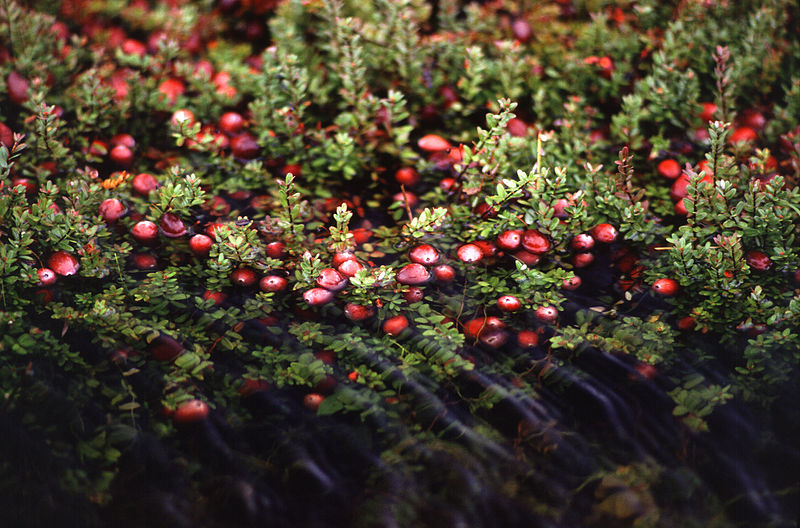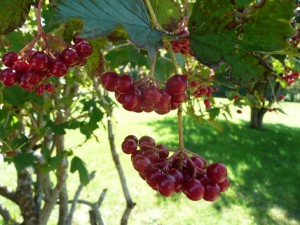Spoonful of sugar helps the cranberries go down

American cranberry (Vaccinium macrocarpon). Photo: Keith Weller, public domain
Like the political process, cranberries can leave a sour taste in your mouth. But unlike politics, whose bitter aftertaste cuts through any amount of sweetener, the flavor of cranberries is readily improved with a little sugar.
To say a fresh cranberry is sour is like saying Paris is a nice town. In fact it (the berry, not Paris) can have a lower pH value than stomach acid. It’s almost a wonder people ever started eating them, right?
The cranberry, which is closely related to blueberries, is native to higher latitudes of the northern hemisphere the world over. It is an evergreen trailing vine, or sometimes a very small shrub. The name is derived from its flower petals, which are reflexed or pulled back sharply, making the its pink blossom resemble (to some) the head and bill of a crane. The North American species is Vaccinium macrocarpon, and luckily for us it has larger berries than species in northern Europe and elsewhere.

Highbush cranberry? Not a cranberry. Photo: librarykyle, Creative Commons, some rights reserved
It’s important to note that the shrub known as highbush cranberry is an imposter and is not nrelated to the stuff we eat on Thanksgiving. This kind of confusion around common names happens a lot. In the plant world there are no copyright laws, which is why pointy-headed plant nerds like yours truly like those fancy Latin names.
Of course we know that Native Americans made use of cranberries, and introduced them to early European immigrants. A firsthand account from the late 1500s describes how some Algonquins brought cups full of cranberries to newly arrived Pilgrims as they came ashore. I’m thinking that unless there was a bit of maple sugar in with the berries, maybe their purpose was actually to discourage the migrants from staying.
The colonists took a shine to the little red sourballs occasionally known as moss berries or bear berries, and by the 1820s some farmers began exporting this new crop back to Europe. Growing them might not look like you’d expect, though—images of cranberries floating on what appears to be a lake give the wrong impression.
Wild cranberries are often found in wet areas such as bogs, but cultivated berries are grown on carefully managed upland fields. These sandy plots, laser-leveled and heavily irrigated, are surrounded by berms so the fields can be flooded with six to eight inches of water to make harvesting easier. Because berries gathered this way have a very short shelf life, they are generally frozen, canned or otherwise processed right away. Cranberries for fresh eating are usually hand-picked in dry fields.
Over the past few decades, cranberries have been touted for an increasingly wide range of health benefits as well as for their taste. It has long been known they are high in Vitamins C and E, pantothenic acid, as well as manganese, copper and other minerals. But it’s their antioxidant properties that have gotten people excited.
If you saw “oligomeric proanthocyanidins” listed on a candy bar you might not buy it. But these and many other natural compounds are abundant in cranberries, and despite the scary names they’re good for you. Cranberries are being intensively studied for potential benefits in treating diabetes, arthritis, cancer and other illnesses.

Cranberries help prevent ulcer-causing bacteria from colonizing human stomach lining. Photo: Stephen Poff, Creative Commons, some rights reserved
Research suggests cranberry juice—the good stuff, not the corn syrup-laden wannabe juice—may help prevent calcium-based kidney stones. Moderation in all things, as too much of it may cause oxalic acid-based bladder stones.
Studies also indicate cranberry juice does prevent certain harmful bacteria from sticking to us. Turns out it’s like Teflon for them. While cranberry juice has not been found effective for treating urinary tract infections, it is good at preventing them by stopping coliform bacteria from adhering to places they don’t belong. Good news for your teeth, too—cranberries help keep decay microbes from glomming on to enamel, thus reducing dental plaque and cavities.
And as the 2016 election campaign machine warms up you’ll be happy to hear that cranberries also help prevent ulcer-causing bacteria from colonizing human stomach lining and forming ulcers. Furthermore, their cardiovascular benefits include lowering “bad” LDL cholesterol blood levels and increasing those of the good HDL cholesterol. So if you’re a news junkie, keep the cranberries close at hand during those debates.
Paul Hetzler is a horticulture and natural resources educator with Cornell Cooperative Extension of St. Lawrence County.
Tags: cranberries, food, nature







